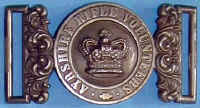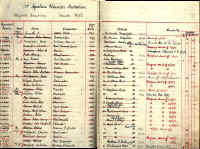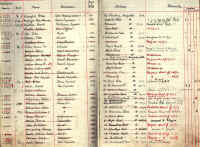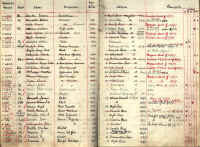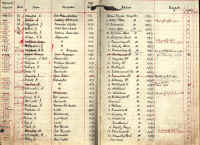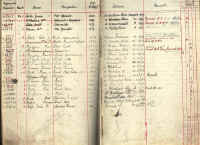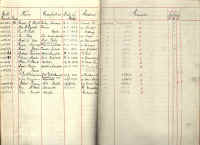|
|
|
The following
text contributed by Ian Kerr in Windsor, Berkshire The volunteer movement began in 1859, in response to a perceived threat of French invasion and in light of the disasters of the Crimean campaign three years earlier (when the French were Britain's allies!). The movement was largely of Rifle (infantry) units as well a smaller number of and Artillery and Engineer Volunteer units sprang up over the next two or three years. They were originally "Independent Volunteer" units, usually called corps to begin with. The new units when formed adopted new titles based on their base county. Many took on fanciful styles, and wore uniforms that emulated those worn by regular regiments. Their members paid for their own uniforms and weapons (rifles, or carbines for Artillery and Engineers) and paid subscriptions for unit expenses. By 1863, the War Office had grown concerned about the growing independence and the size of the movement (the numbers of men had grown from none in May 1859 to 170,000 in May 1861). The War Office began horse-trading of some central funding in return for standardisation of uniforms, training and the introduction of War Office control of the Volunteer units. The Militias and the Volunteers continued to function side-by-side, with varying degrees of informal co-operation, until 1881. The 1st Admin Battalion of the Ayrshire Rifle Volunteers was formed in 1860 and soon contained the 14 individual corps of riflemen that had been raised throughout the county as part of the Rifle Volunteer movement. This number of units proved too cumbersome to be easily managed. So in 1873 the battalion was divided in two. The 2nd Admin Battalion had its headquarters in Kilmarnock and its companies were in north Ayrshire. This battalion was consolidated in 1880 as the 1st Ayrshire Rifle Volunteer Corps. In 1887, it was renamed the 1st Volunteer Battalion, The Royal Scots Fusiliers. In common with other volunteer units, the battalion contributed a number of men to the Imperial Volunteers who served in the South African War (1899 - 1902). With the Haldane reforms creating the Territorial Force in 1908, the battalion became the 4th Battalion, The Royal Scots Fusiliers (Territorial Force). In 1914, the battalion consisted of a Headquarters at Kilmarnock, A Company at Kilmarnock, B Company at Irvine, C Company at Stewarton, D Company at Beith, E Company at Saltcoats, F Company at Dalry, G Company at Darvel and H Company at Kilmarnock. The Ardeer Company, (Territorial Force) formed in 1913 by Nobel's Explosives Factory to guard their factory at Ardeer in the event of war, was attached to 4th Battalion, Royal Scots Fusiliers When the 1st Admin Battalion of the Ayrshire Rifle Volunteers was divided in 1873, those companies in the south of the county remained under that title. But in 1880 it became the 2nd Ayrshire Rifle Volunteer Corps and in 1887, the 1st Volunteer Battalion, The Royal Scots Fusiliers. With the Haldane reforms creating the Territorial Force in 1908, the battalion became the 5th Battalion, The Royal Scots Fusiliers (Territorial Force). In 1914, the battalion consisted of a Headquarters and A Company at Ayr, B Company at Catrine, C Company at Maybole, D Company at Stranraer, E Company at Cumnock, F Company at Troon, G Company at Muirkirk and H Company at Dalmellington. [At some point, perhaps after 1914, Maybole became B company as some of the later pages are headed "B Coy 1/1 Bn Ayrshire Volunteer Regiment"] Since the volunteer companies tended to reflect their original town affiliations, it would seem the Maybole Corps of the Ayrshire Rifle Volunteers was that which evolved into C Company, 5th Battalion, The Royal Scots Fusiliers (Territorial Force). The following text is from Maybole, Carrick's Capital Facts, Fiction & Folks by James T. Gray In 1859 once again there were rumours and alarms of an invasion by the "Froggies" across the English Channel and the Maybole men, as their fathers had done in 1797, decided to form a unit to assist in the defence of the country. The Volunteer movement sprang up throughout Britain at this time and General Peel, War Minister of the Government, agreed, to accept the services of such men as would equip themselves at their own expense, ask for no pay and fight when needed, and to everyone's astonishment an armed force of over one hundred thousand men was enrolled within a short time, having as their motto "Defence not Defiance". Although the danger from France passed away the Volunteer movement had come to stay and continued to the present day in various forms until in 1968 the Territorial Army was more or less disbanded. After a great deal of wrangling among the would be officers of the corps, the Minniebolers in January, 1860, subscribed £200 to equip the men and by March of that year the Maybole corps of the Ayrshire Rifle Volunteers was formed. It consisted of eighty men and the officers elected were: David Brown, Writer, Captain; William Murray, Writer, lieutenant; Thomas Austin, ensign; Dr. Girvan, surgeon; Richard Parkinson, bugler; Rev. John Thomson, minister in West Parish Church, chaplain. The officers were dressed in befrogged frock coats and the men in blue tunics and grey drill trousers with pill box caps. These leaders faithfully drilled their men until they were well able to compete with the other companies of the Ayrshire Battalion (which comprised over 1,000 men under the command of the Marquess of Ailsa who had been gazetted Lieutenant-Colonel of the Rifle Volunteers) when shooting matches, etc., were held and indeed the Maybole rifle team won many trophies on the range. By 1879 the Ayrshire Battalion was composed of fifteen companies and the war office in 1880 split them into two battalions, which were in being until 1887 when the 2nd Battalion, which had its headquarters in Ayr, became the 2nd Rifle Volunteer Battalion of the Royal Scots Fusiliers. The Maybole men were formed into "C" company of the 2nd Rifle Volunteer Battalion of the R.S.F. and many of the locals drilled in the Sheep Park or at the Town Green, practised shooting in the old "Armoury" and made a bee line for "Bobby Gerrand's" in the Kildoup when dismissed from their labours. The Minniebolers never were in favour of being connected with the R.S.F. and staunchly adhered to be the old form of "Ayrshire Rifle Volunteers" when speaking about themselves. Many medals earned by these Maybole volunteers must still be in the possession of some of their descendants and the writer has the dress sword and pill box diced cap belonging to his grandfather, together with a long service medal inscribed "Ayrshire Rifle Volunteers; "C" Company 2nd V.B.R.S. Fusiliers", with Britannia crowning a soldier with a laurel wreath on one side, and "Presented to Lieut. H. B. Gray for long service; enrolled 8th March, 1860, retired 22nd May, 1891" on the other. On 25th August, 1881, the famous "Wet Review" took place when over 40,000 Volunteers from all over Britain paraded before Queen Victoria in Queens Park, Edinburgh. The 2nd Ayrshire Rifles were present, 88 strong, and many Maybole men from "C" Company made up the Ayrshire contingent. They left Maybole by train for Ayr before 5 o'clock that morning, joined up with the Ayr riflemen, then left at 5.30 a.m. by special train for Edinburgh and on arrival there they found the skies dull and overcast but all hoped the rain would keep off until after the review. Unfortunately this was not to be and long before the parade commenced the heavens opened and there was such a deluge that the streets were flooded and Hunters Bog, where the troops were to gather, became a perfect quagmire. It was decided to carry on, however, and the Queen reviewed her citizen army in a steady downpour with spectators, and riflemen alike being drenched to the skin. The volunteers, especially, were in a sad state, with the pipeclay from their belts and the dye from their uniforms running in streaks down their grey drill trousers. Notwithstanding the rain the day was a great success and the Maybole men returned to their home town around 6 a.m. the following morning, tired and bedraggled but still in high spirits and able to muster and march behind their band to the Town Hall where they fell out to return to their homes and brag for evermore that they had been present at the "Wet Review". Through time the Volunteers merged into the Territorials in 1908 which always had a good quota of Maybole men until the powers that be decreed in 1968 that the Territorial Army was no longer required. When the Boer War broke out many of the Volunteers in the town joined fighting units as they wished to see action and the Volunteers were for home defence only, as were the Home Guard of the Second World War. On their return from active service in South Africa they were feted by the townspeople and some, who had especially distinguished themselves, were made Honorary Burgesses. The now commonplace khaki uniform was introduced at this time and some of the soldiers brought back their tunics and wore them at their work and the older people in the town well remember "Khaki" Campbell who worked on a local farm and got his nickname because he wore an old Khaki tunic. |
